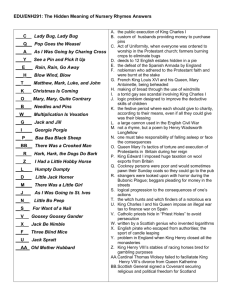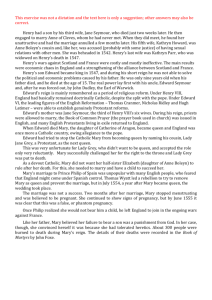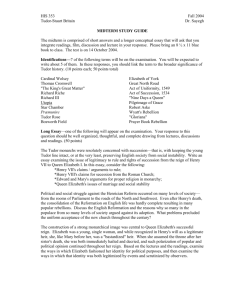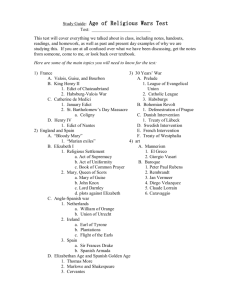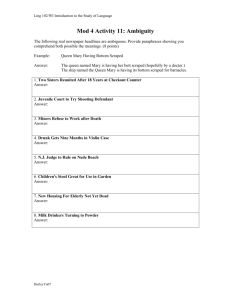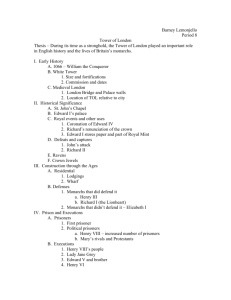File - AndAllThat.co.uk
advertisement
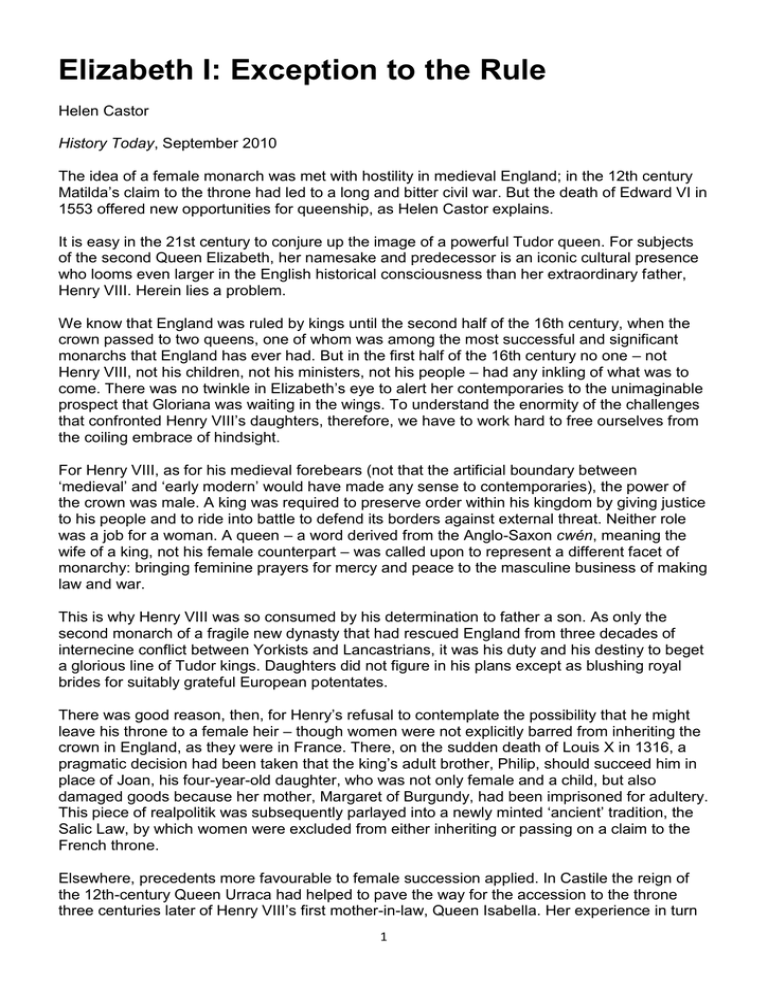
Elizabeth I: Exception to the Rule Helen Castor History Today, September 2010 The idea of a female monarch was met with hostility in medieval England; in the 12th century Matilda’s claim to the throne had led to a long and bitter civil war. But the death of Edward VI in 1553 offered new opportunities for queenship, as Helen Castor explains. It is easy in the 21st century to conjure up the image of a powerful Tudor queen. For subjects of the second Queen Elizabeth, her namesake and predecessor is an iconic cultural presence who looms even larger in the English historical consciousness than her extraordinary father, Henry VIII. Herein lies a problem. We know that England was ruled by kings until the second half of the 16th century, when the crown passed to two queens, one of whom was among the most successful and significant monarchs that England has ever had. But in the first half of the 16th century no one – not Henry VIII, not his children, not his ministers, not his people – had any inkling of what was to come. There was no twinkle in Elizabeth’s eye to alert her contemporaries to the unimaginable prospect that Gloriana was waiting in the wings. To understand the enormity of the challenges that confronted Henry VIII’s daughters, therefore, we have to work hard to free ourselves from the coiling embrace of hindsight. For Henry VIII, as for his medieval forebears (not that the artificial boundary between ‘medieval’ and ‘early modern’ would have made any sense to contemporaries), the power of the crown was male. A king was required to preserve order within his kingdom by giving justice to his people and to ride into battle to defend its borders against external threat. Neither role was a job for a woman. A queen – a word derived from the Anglo-Saxon cwén, meaning the wife of a king, not his female counterpart – was called upon to represent a different facet of monarchy: bringing feminine prayers for mercy and peace to the masculine business of making law and war. This is why Henry VIII was so consumed by his determination to father a son. As only the second monarch of a fragile new dynasty that had rescued England from three decades of internecine conflict between Yorkists and Lancastrians, it was his duty and his destiny to beget a glorious line of Tudor kings. Daughters did not figure in his plans except as blushing royal brides for suitably grateful European potentates. There was good reason, then, for Henry’s refusal to contemplate the possibility that he might leave his throne to a female heir – though women were not explicitly barred from inheriting the crown in England, as they were in France. There, on the sudden death of Louis X in 1316, a pragmatic decision had been taken that the king’s adult brother, Philip, should succeed him in place of Joan, his four-year-old daughter, who was not only female and a child, but also damaged goods because her mother, Margaret of Burgundy, had been imprisoned for adultery. This piece of realpolitik was subsequently parlayed into a newly minted ‘ancient’ tradition, the Salic Law, by which women were excluded from either inheriting or passing on a claim to the French throne. Elsewhere, precedents more favourable to female succession applied. In Castile the reign of the 12th-century Queen Urraca had helped to pave the way for the accession to the throne three centuries later of Henry VIII’s first mother-in-law, Queen Isabella. Her experience in turn 1 served to fuel the determination of her daughter, Henry’s rejected wife, Catherine of Aragon, that her own daughter Mary was a worthy heir to the English crown. In England itself, however, history was not so encouraging. The claim of Matilda, Henry I’s daughter, to inherit the throne on his death in 1135 had resulted not in the reign of England’s first female monarch but in 18 years of civil war, ‘when Christ and his saints slept’, as Matilda’s supporters battled with those of Henry’s nephew, Stephen of Blois. The lesson learnt from that devastating conflict was provisional and problematic. Matilda’s rights as her father’s heir were vindicated in the Treaty of Winchester that ended the war in 1153, but only in the person of her son, who became king as Henry II. Royal women in England, then, could pass the crown on to their male offspring. That much was clear, not only from the outcome of Matilda’s doughty struggle, but also from the English kings’ claim to the throne of France, a claim in which Henry VIII believed as fiercely as his predecessors and which derived from Louis X’s sister, Isabella, the wife of Edward II of England. Henry’s claim to England also depended on a woman: his grandmother, the formidable Lancastrian heiress, Margaret Beaufort, who had watched with grim satisfaction as her only son was crowned in 1485 as Henry VII. But if Westminster Abbey had not rung with cheers at the coronation of Queen Margaret Beaufort, did that mean that women could not rule in England? Luckily for Henry VIII, the outcome of his convoluted matrimonial career relieved him of the necessity to face the question directly. His son Edward – a slender, solemn and precociously erudite boy, thanks to the finest humanist education his father could provide – stood ready to succeed him. It was not part of Henry’s plan that he should die while his heir was still a child. When Henry died in 1547 the new King Edward VI was only nine and no more capable of performing the functions of kingship than were his sisters. But, being male, his incapacity was only temporary; and his ministers, led first by the Duke of Somerset and then by the Duke of Northumberland, could govern in his name while they waited for him to grow to adulthood. On the slight shoulders of this boy rested Henry’s hopes for the future of the Tudor dynasty. Meanwhile, the old king’s will contained provisions that Henry saw as explicitly provisional – contingencies in the unthinkable event that something should happen to Edward before he could marry and father sons of his own. In that case, Henry declared, his own blood should prevail and his daughters should inherit his crown despite his unwavering insistence, in other contexts, that they were illegitimate. It was a tribute to Henry’s overwhelming personal authority that the tacit contradiction between his daughters’ bastardy (which had been enshrined in statute law in the 1530s) and their standing as his heirs was not challenged in his lifetime. Edward, however, had other ideas. When the young king sat down in early 1553, straining with a feverish cough that he was struggling to shake off, to draft his own ‘device for the succession’, he had as yet no children of his own to cloud the methodical rigour of his logical mind. Unlike his father, he was a fervent believer in the evangelical Protestantism to which the Henrician Reformation had opened the door in England. That meant that his half-sister Mary – an equally fierce believer in the Church of Rome – was an unacceptable heir to his throne. More than that, the scriptural emphasis of Protestant theology raised questions about the entire prospect of female sovereignty. Had not St Paul said that ‘man is the head of woman’? How then could the rule of a woman be anything but unjust and unlawful? Edward’s ‘device’, therefore, provided for a new descent of the English crown through a line of heirs who, according to his specifications, would be both Protestant and male. Here, however, 2 reality failed to match up to well-ordered theory. The extraordinary fact was that, after Edward, there was no one left to claim the title of king of England because all the possible contenders for his throne were female. This unprecedented lack of a king-in-waiting was in part the result of Tudor paranoia about the dilute solution of royal blood that flowed through the Tudor line itself. Henry VII’s Beaufort claim came via the illegitimate offspring of Edward III’s son, John of Gaunt; a bastard family who had later been legitimised by Act of Parliament but explicitly excluded from the royal succession. Henry VIII’s dynastic claims were less tenuous, thanks to his mother, Elizabeth of York, the eldest daughter of Edward IV and sister of the murdered princes in the Tower. But neither of the two Henrys would ever admit that her role had been more than that of a fitting consort for the ‘rightful’ Tudor monarch. Meanwhile, both kings had engaged in a cull of the surviving representatives of the Plantagenet bloodline. Few of Elizabeth of York’s royal cousins died in their beds; some were cut down on the battlefield, others on the block. Violence had brought the Tudors to the throne and violence now left them unchallenged in possession of it. But this new dynasty was a young sapling compared with the Plantagenet family tree and had produced few boys to leaf its branches. Edward himself had two half-sisters, Mary and Elizabeth. Henry VIII’s two sisters, Margaret and Mary, were both dead. They had each left female heirs: Margaret’s granddaughter Mary, Queen of Scots, and Mary’s daughter, Frances Brandon, Duchess of Suffolk, who had three unmarried daughters of her own, Jane, Katherine and Mary Grey. It was a profoundly unreassuring prospect; but at least Edward’s new prescriptions for the succession had the benefit of clarity. His half-sisters, he reasoned, were not legitimate and his Scottish cousin was not Protestant; which left his Grey cousins as the means by which the crown would pass, after the model of his great-grandmother Margaret Beaufort, through the female line to rest on the male head of one of their as yet unborn sons. In any case, for the ailing king, ‘not doubting in the grace and goodness of God but to be shortly by his mighty power restored to our former health and strength’, the claims to the throne of the Grey girls were merely a safety net rather than an imminent political reality. Yet by May 1553 there was no longer any doubt that Edward was dying; tuberculosis had taken hold. If the king still laboured under any delusions about his prospects of recovery, the Duke of Northumberland could not afford to indulge them, since the twin imperatives of safeguarding the newly reformed Edwardian Church and securing the duke’s own political future were now matters of critical urgency. At the beginning of June Edward once more took up his pen to amend his ‘device’ for the succession. Where the original draft spoke of the crown descending to the unborn sons of Frances Brandon’s eldest daughter – ‘the Lady Jane’s heirs male’ – the king now altered the text to read ‘the Lady Jane and her heirs male’. With the addition of two small words Jane Grey was named the heir to Edward’s crown. When Edward died on July 6th, 1553, transformed by his illness and the noxious treatments he had endured into a figure of grotesque pathos, she became the first woman to be proclaimed as England’s sovereign. 3 Jane Grey’s story – the tragic history of the nine-days’ queen – is now so familiar that it is easy to overlook the complexity of the questions it raised for contemporaries who had no way of knowing how events would unfold. Seen from the pragmatic perspective of an attempt to safeguard political and religious continuity, Jane seemed the perfect candidate to be Edward’s successor: a fiercely devout adherent of the same evangelical faith as Edward himself and daughter-in-law of the Duke of Northumberland, having hastily married his son, Guildford Dudley, a few weeks before Edward’s death. But, viewed from outside the corridors of power at Greenwich and Westminster, her sudden elevation made so little sense as to cause consternation and confusion. Even those few of her new subjects who knew who she was (something which the proclamation of her accession on July 10th spent quite some time explaining) struggled to understand why she should now be queen rather than her mother, through whom her claim to the throne was said to have come. In fact, Jane Grey’s theoretical claim to the crown made sense not as part of any wholesale recognition of female succession, but only as a lone anomaly through whom the future rule of Edward’s imagined line of Protestant kings could be secured. That in turn would depend on an acceptance that Edward had the power to overturn his father’s will and Acts of Parliament, not to mention the more nebulous weight of precedent, to impose his own vision of how England’s monarchs should be selected. It rapidly emerged that such acceptance would not be forthcoming. Legitimacy – as defined not by the technical legal verdict on the circumstances of her birth, but by the English people’s perception of her status – lay with Mary, the elder of Henry VIII’s two daughters. As thousands mustered under her standard at her castle of Framlingham in Suffolk and support haemorrhaged from the Duke of Northumberland’s regime, it began to be clear that the crown would come to rest on the head of Queen Mary Tudor rather than Queen Jane Grey. With Mary’s victory, the underlying question of whether a woman could wear the crown in England was settled, at last, by default: there was no alternative. It had been Mary’s sex that had compromised her standing in her father’s eyes as his heir, but the fact that she was female could hardly now be used against her by Jane’s supporters. 4 It could, however, be exploited to vituperative effect by those who reviled the Catholic faith that Mary was determined to restore in England. Most resounding of all was The First Blast of the Trumpet Against the Monstrous Regiment of Women, unleashed from Geneva in 1558 by the Protestant firebrand John Knox. Female ‘regiment’ (or regimen, meaning rule or governance) was ‘monstrous’ (that is, unnatural and abominable) because women were doubly subordinate to men: once by reason of Eve’s creation from Adam’s rib and again because of her transgression in precipitating the fall from Eden. Therefore, ‘to promote a woman to bear rule, superiority, dominion or empire above any realm, nature or city is repugnant to nature, contumely to God, a thing most contrarious to his revealed will and approved ordinance, and finally it is the subversion of good order, of all equity and justice’, Knox ringingly declared, before elaborating several thousand words of largely circular variation on that pungent theme. The polemics of Knox and his co-religionists were an irritation to Mary, albeit one whose sting was drawn by the fact that the hopes of the Protestant cause in England were vested in her half-sister Elizabeth, who was also, more percipient observers noted, a woman. But it was the presence of this heir of distressingly different religious views – however much Elizabeth might, characteristically, be trimming her sails to the prevailing winds at Mary’s Catholic court – that presented the new queen with her most fundamental challenge as a female sovereign. Mary’s subjects and her closest allies expected that her first task as queen would be to marry. ‘You will point out to her,’ the Holy Roman Emperor Charles V told his envoys in England, ‘that it will be necessary, in order to be supported in the labour of governing and assisted in matters that are not of ladies’ capacity, that she soon contract matrimony with the person who shall appear to her most fit from the above point of view.’ It is possible that Mary, as a devoutly conservative woman, agreed with this analysis; although she later informed the emperor’s ambassador that, while she intended to love and obey her husband, ‘if he wished to encroach in the government of the kingdom she would be unable to permit it’. But the inescapable fact of the matter was that Mary, at 37, did require a husband – and quickly – if she were to give birth to an heir. That was a necessity, because it was an intolerable prospect that her own death should deliver the crown to Anne Boleyn’s bastard and England into heresy. The difficulty was that husbands, as everyone knew, had authority over their wives. If England’s first reigning queen took a husband, would her kingdom acquire a king? That unsettling possibility persuaded many of her subjects that their queen should marry an Englishman, for fear, as the emperor ruminated, that ‘foreigners, whom the English more than any other nation abhor, would interfere with the government’. However, Mary’s response when a parliamentary delegation put that proposition to her was unequivocal. ‘Parliament was not accustomed to use such language to the kings of England,’ she told the unfortunate Speaker trenchantly, ‘nor was it suitable or respectful that it should do so.’ How could she love and obey a man who was already bound in obedience to her? Only outside her realm would she find a husband whose status was commensurate with her own. And so, on July 25th, 1554 Mary married a man who was already a king: her cousin Philip of Spain, the son of the emperor who had so forthrightly urged marriage upon her. There are good grounds for thinking that Philip was the best of the limited choices available to her, all of which were problematic in one way or another. In fact, the treaty hammered out to give effect to a marriage that was supposedly made necessary by the limitations of the queen’s sex went to great lengths to prevent her husband from intervening in the government of her kingdom. If her councillors believed that she could not rule without a husband’s help, it was a principle they were eager to waive, it turned out, if the husband in question was Spanish. Philip would have the title of king in England, but none of the authority – provisions which protected English 5 interests and the independence of Mary’s sovereignty so effectively that Philip privately vowed that he held himself bound by none of them. Yet still Mary found herself toiling to free herself from the contradictions between being a woman and being a sovereign. For all the uncompromising drafting of her marriage treaty and for all Mary’s careful distinction between her private duty as a wife and her public responsibility as a monarch, everything that her subjects knew about the relative authority of husband and wife served to fuel fears that her marriage to Philip would subject England to Spanish rule. He was now king of England and kings, they knew, ruled. Queens, in general, did not. It could have been different. Had one of Mary’s heartbreaking phantom pregnancies produced a living heir England’s future might have lain in union with Philip’s territory of the Netherlands under the rule of a Catholic monarch. Had she lived into her fifties, like her mother and father, the Catholicism she had so faithfully and forcefully replanted in her kingdom might have taken deeper root. But in November 1558, at the age of just 42, Mary succumbed to a virulent bout of influenza and her crown passed to her 25-year-old half-sister, Elizabeth, a woman who had been blessed not only with a quicksilver intelligence, but with the opportunity to observe at close quarters the travails of England’s first queen regnant before she became its second. Only six months after his First Blast had been published, the accession of this Protestant queen confronted John Knox with the urgent need to execute an undignified about-turn on the subject of female rule. He wrote to the clearly affronted queen to explain that he had not meant to include her authority, providentially ordained by God as it was, in his thundering condemnation of all women rulers. Typically, however, he could not resist the opportunity to offer Elizabeth the benefit of his unsolicited advice: ‘If thus in God’s presence you humble yourself, as in my heart I glorify God for that rest granted to his afflicted flock within England under you, a weak instrument, so will I with tongue and pen justify your authority and regiment as the Holy Ghost has justified the same in Deborah’ – Deborah being the lone female Judge in Old Testament Israel. Elizabeth was not impressed. When Knox returned from Geneva to Scotland in 1559, she would not let him set foot on English soil, forcing him to brave the more dangerous North Sea route to Leith. But she was happy to adopt the proffered mantle of a biblical Deborah; not the first of a new breed of female kings, but a single providential exception to the rule of male sovereignty. Difficult though it may be, it is important to remember that Elizabeth did not take the throne as Gloriana, but as a young woman whom everyone – ministers, subjects, allies and enemies – expected to marry and to marry soon for exactly the same reasons as her sister had done. Instead, little by little, as year followed year, she chose a different path: to exercise power not by blazing a trail for female rule in general, but by establishing herself as something unique. Women were weak and unsuited to rule, that she accepted; but by God’s will she was different – more than human, a goddess and an icon as well as a queen. Of course the nature of her unique power meant that, by definition, the Virgin Queen could not do the one thing that was the sine qua non of kingship: to pass on the throne to an heir of her own bloodline. Instead she showed that symbolic power, deployed with precision, intelligence and charisma, could be an extraordinary weapon in the crown’s arsenal; indeed, one that has become the foundation of the crown’s endurance into the modern world. She did it to such great effect that we have to work much harder than we realise to read the story of female sovereignty forwards, with all its uncertainties and possibilities, rather than backwards from our knowledge of her iconic end. 6 Helen Castor is a Fellow of Sidney Sussex College, Cambridge and the author of She-Wolves: The Women Who Ruled England Before Elizabeth, published by Faber and Faber this month. Further reading: Charles Beem, The Lioness Roared: The Problems of Female Rule in English History (Palgrave Macmillan, 2006) Antonia Fraser, The Warrior Queens: Boadicea's Chariot (Phoenix Press, 2002) Eric Ives, Lady Jane Grey: A Tudor Mystery (Wiley-Blackwell, 2009) Judith Richards, Mary Tudor (Routledge, 2008) Oxford Dictionary of National Biography (Oxford University Press, 2004), available online to members of UK public libraries 7
